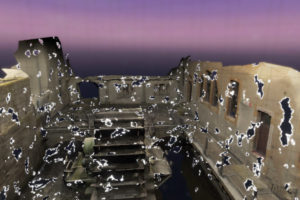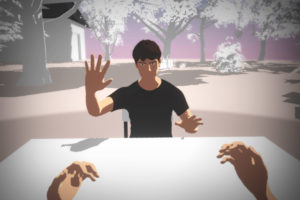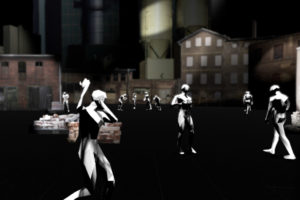
What do you see when you close your eyes?
Exhibition
The exhibition »What do you see when you close your eyes?« which was developed during the THIS IS FAKE – RESIDENCY I consists of four content-related virtual reality works, spatial installations, objects and an archive. The starting point were various questions about the central term »reminiscence«, which arise in the fields of tension between virtual reality, digitization and the real reality of a city like Zeitz in Saxony-Anhalt. Using techniques such as immersion, embodiment and digital recording, personal narratives of East German identity, German unity and post-reunification are brought together with topics of internet culture such as online identities and avatarism. Together, the pieces add up to a multimedia composition with a total stay of around 45 minutes.
The first VR piece called »MEMORY« enables the viewer to connect spaces and places that have been digitally preserved with the help of photogrammetry to personal stories and experiences of people from Zeitz. Conceptual spaces emerge which re-construct and highlight the topics of childhood and adolescence in the GDR, workmanship, German reunification and the time after the reunification.
In the VR work »REFLECTION«, the viewer is literally put into an extraordinary situation: while one’s body is apparently replaced by an animation recorded using motion capture, the own movements are transmitted to the person opposite. Due to this shift in external and self-perception and also the feeling of double presence, the conversation with the actress Henriette Rossner-Sauerbier, who lives and works in Zeitz, turns into a dialogue not only about her personal history around the reunification but also about the visitor’s own experiences.
The world is changing, and with it the environment of work as we know it today. The VR piece »MOTION« negotiates the disappearance of workmanship in a theater-like setting. Low-poly style avatars perform heavy physical work, which movements were captured by motion capture, but without actually working on the space or on visible materials.
»The future is already here – it’s just not very evenly distributed.« – William Gibson. The fourth VR piece »FICTION« invites the viewer to choose a new body in the form of an avatar inside a room similar to a dressing room. »You can be whatever you want!« is the postulate. The constructions of sexuality, gender, ancestry and physical characteristics will no longer play a role in a utopian future. At the same time, interviews can be heard from people who are already spending their time in digital worlds and are speaking about their experiences with avatars.
A connecting element in the exhibition is the archive, the »Internet Café« with two computers. Finds of analog photos, CDs, VHS tapes and other interview excerpts are stored there. With a mouse click, visitors can navigate through the artefacts and learn more about Zeitz, the GDR and the post-reunification period.
Media (German Only):
»Selbstentdeckung in der digitalen Nudel« (Zeitz Online),
»In der Nudel wird es virtuell« (Zeitz Online),
»Sektstunden Qualität in fremden Küchen: Live aus Zeitz« (Radio Corax)
Lenn Blaschke, Leon Galli, Julie Hart und Farina Hamann
Zeitz, June 2020
Organizer of the residency: THIS IS FAKE
Special thanks to: Lukas Rosenkranz, Paul Maisel, Birgit und Mathias Mahnke







